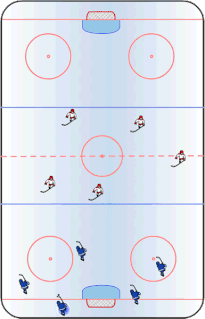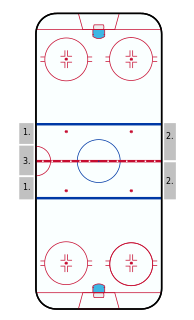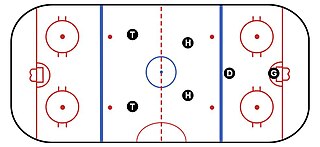Related Research Articles

Ice hockey is a team sport played on ice skates, usually on an ice skating rink with lines and markings specific to the sport. It belongs to a family of sports called hockey. In ice hockey, two opposing teams use ice hockey sticks to control, advance and shoot a closed, vulcanized, rubber disc called a "puck" into the other team's goal. Each goal is worth one point. The team which scores the most goals is declared the winner. In a formal game, each team has six skaters on the ice at a time, barring any penalties, one of whom is the goaltender. Ice hockey is a full contact sport.

In many team sports, defense or defence is the action of preventing an opponent from scoring. The term may also refer to the tactics involved in defense, or a sub-team whose primary responsibility is defense. Similarly, a defense player or defender is a player who is generally charged with preventing the other team's forwards from being able to bear down directly on their own team's goalkeeper or goaltender. Such positions exist in association football, ice hockey, water polo and many other sports.

In ice hockey, a goal is scored when the puck entirely crosses the goal line between the two goal posts and below the goal crossbar. A goal awards one point to the team attacking the goal scored upon, regardless of which team the player who actually deflected the puck into the goal belongs to. Typically, a player on the team attempting to score shoots the puck with their stick towards the goal net opening, and a player on the opposing team called a goaltender tries to block the shot to prevent a goal from being scored against their team.

The centre in ice hockey is a forward position of a player whose primary zone of play is the middle of the ice, away from the sideboards. Centres have more flexibility in their positioning and therefor often end up covering more ice surface than any other player. Centres are ideally strong, fast skaters who are able to back-check quickly from deep in the opposing zone. Generally, centres are expected to be gifted passers more so than goal scorers, although there are exceptions - typically larger centres who position themselves directly in front of the net in order to score off rebounds. They are also expected to have exceptional "ice vision", intelligence, and creativity. They also generally are the most defensively-oriented forwards on the ice, as they are expected to play the role of the third player in defense, after the defencemen. Centres usually play as part of a line of players that are substituted frequently to keep fresh and keep the game moving.
In ice hockey, a forward is a player, and a position on the ice, whose primary responsibility is to score and assist goals. Generally, the forwards try to stay in three different lanes of the ice going from goal to goal. It is not mandatory, however, to stay in a lane. Staying in a lane aids in forming the common offensive strategy known as a triangle. One forward obtains the puck and then the forwards pass it between themselves making the goalie move side to side. This strategy opens up the net for scoring opportunities. This strategy allows for a constant flow of the play, attempting to maintain the control of play by one team in the offensive zone. The forwards can pass to the defence players playing at the blue line, thus freeing up the play and allowing either a shot from the point or a pass back to the offence. This then begins the triangle again.

Winger, in the game of ice hockey, is a forward position of a player whose primary zone of play is along the outer playing areas. They typically flank the centre forward. Originally the name was given to forward players who went up and down the sides of the rink. Wingers generally have the least defensive responsibilities out of any position on the ice, however they are still tasked with defensive duties such as forechecking duties or covering the point in the defensive zone.

Defence or defense in ice hockey is a player position that is primarily responsible for preventing the opposing team from scoring. They are often referred to as defencemen, D, D-men or blueliners. They were once called cover-point.

An ice hockey rink is an ice rink that is specifically designed for ice hockey, a competitive team sport. Alternatively it is used for other sports such as broomball, ringette, rinkball, and rink bandy. It is a rectangle with rounded corners and surrounded by walls approximately 1.22 metres (48 in) high called the boards.
Checking in ice hockey is any of a number of defensive techniques aimed at disrupting an opponent with possession of the puck or separating him from the puck entirely. Most types are not subject to penalty.

The neutral zone trap is a defensive strategy used in ice hockey to prevent an opposing team from proceeding through the neutral zone and to force turnovers.
The point is a term in ice hockey to indicate a position inside the opposition's blue line along the edges of the rink.
In ice hockey, a play is offside if a player on the attacking team does not control the puck and is in the offensive zone when a different attacking player causes the puck to enter the offensive zone, until either the puck or all attacking players leave the offensive zone. Simply put, the puck must not enter the attacking zone after attacking players. If a player on the attacking team is in the offensive zone before the puck, either an immediate offside occurs, or they must retreat to the neutral zone.

Roller inline hockey, or inline hockey is a variant of hockey played on a hard, smooth surface, with players using inline skates to move and hockey sticks to shoot a hard, plastic puck into their opponent's goal to score points. The sport is a very fast-paced and free-flowing game and is considered a contact sport, but body checking is prohibited. There are five players including the goalkeeper from each team on the rink at a time, while teams normally consist of 16 players. There are professional leagues, one of which is the National Roller Hockey League (NRHL). While it is not a contact sport, there are exceptions, i.e. the NRHL involves fighting.

The Miracle on Manchester is the nickname given to a National Hockey League (NHL) playoff game between the Los Angeles Kings and Edmonton Oilers that took place on April 10, 1982 in the league's 65th season. The game, the third in a best-of-five postseason series, was played at The Forum, the Kings' home arena at the time, which was situated on Manchester Boulevard in the Los Angeles suburb of Inglewood. The Kings completed the largest comeback in NHL playoff history, going from being down 5-0 to win the game 6-5 in overtime. Combined with upset wins in Games 1 and 5, the Kings eliminated the heavily favored Wayne Gretzky-led Oilers in a 3-2 series victory to reach the second round.

The National Hockey League rules are the rules governing the play of the National Hockey League (NHL), a professional ice hockey organization. Infractions of the rules, such as offside and icing, lead to a stoppage of play and subsequent to the offending teams. The league also determines the specifications for playing equipment used in its games.
This is a list of common terms used in ice hockey along with the definition of these terms.
Loafing, floating, or cherry picking in ice hockey is a manoeuver in which a player, the floater, literally loafs — spends time in idleness — or casually skates behind the opposing team's unsuspecting defencemen while they are in their attacking zone. It is very similar to the cherry picking tactic sometimes used in basketball. Its controversy is also very similar to that of cherry picking in basketball.
The forecheck is an ice hockey defensive coverage play made (primarily) in the offensive zone with the objective of applying pressure to the opposing team to regain control of the puck. It is a type of checking. Forechecking is generally executed in one of three situations: recovery of the puck after a dump in, after the rebound following a scoring attempt, or immediately after a turnover to regain possession. Forechecking can be aggressive or conservative depending on the coaching style and on the skating skills of the players.

The torpedo system is an ice hockey on-ice system first used by the Swedish team Djurgårdens IF. The coach of Djurgårdens IF, Hardy Nilsson, took the system with him and it was used extensively by the Swedish national hockey team in international competition. The system converts the traditional hockey layout of three forwards and two defensemen, into two torpedoes up front, two halfbacks, and one lone defenceman. The torpedoes are responsible for forechecking in the corners when the puck is in the offensive zone, and stay around the neutral zone to be sprung into a scoring position. The halfbacks are all-purpose players that run the offense from the faceoff circles in the offensive zone, and defend against the other team's torpedoes. The libero protects the rear of the ice.
The defensive zone coverage refers to the ice hockey defensive (coverage) situation that involves the protection of the own net against being scored on in the defensive zone. The term mainly refers to various systems and tactics used by teams when trying to defend against possession of the puck by the opponent in their own zone. A good D-zone coverage strategy is an imperative part of success at the higher levels of ice hockey, as it not only stops goals from being scored against but also forces the play out of the D-zone and into the higher areas of the ice.
References
- ↑ Dunn, Tricia; Katie King (1999). Gold Medal Ice Hockey for Women and Girls. Chandler House Press. p. 109. ISBN 978-1-886284-37-1.
- 1 2 Walter, Ryan; Mike Johnston (2009). Hockey Plays and Strategies. Human Kinetics. p. 94. ISBN 978-0-7360-7634-0.
- 1 2 3 4 5 6 Raimondo, Gianni (July 2007). "2-1-2 Forecheck (Pinch on a Wide Rim)". Hockey Player Magazine. Archived from the original on 29 April 2010. Retrieved 4 March 2010.